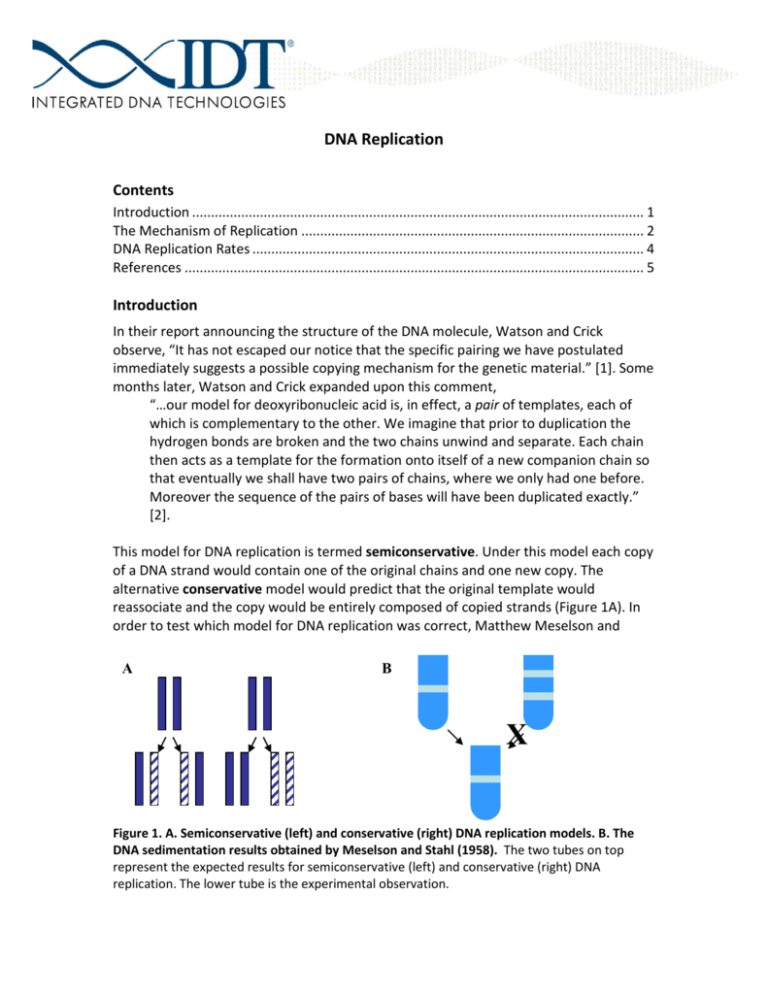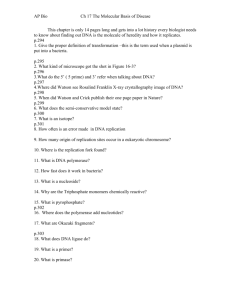
DNA Replication
Contents
Introduction ........................................................................................................................ 1
The Mechanism of Replication ........................................................................................... 2
DNA Replication Rates ........................................................................................................ 4
References .......................................................................................................................... 5
Introduction
In their report announcing the structure of the DNA molecule, Watson and Crick
observe, “It has not escaped our notice that the specific pairing we have postulated
immediately suggests a possible copying mechanism for the genetic material.” [1]. Some
months later, Watson and Crick expanded upon this comment,
“…our model for deoxyribonucleic acid is, in effect, a pair of templates, each of
which is complementary to the other. We imagine that prior to duplication the
hydrogen bonds are broken and the two chains unwind and separate. Each chain
then acts as a template for the formation onto itself of a new companion chain so
that eventually we shall have two pairs of chains, where we only had one before.
Moreover the sequence of the pairs of bases will have been duplicated exactly.”
[2].
This model for DNA replication is termed semiconservative. Under this model each copy
of a DNA strand would contain one of the original chains and one new copy. The
alternative conservative model would predict that the original template would
reassociate and the copy would be entirely composed of copied strands (Figure 1A). In
order to test which model for DNA replication was correct, Matthew Meselson and
A
B
X
Figure 1. A. Semiconservative (left) and conservative (right) DNA replication models. B. The
DNA sedimentation results obtained by Meselson and Stahl (1958). The two tubes on top
represent the expected results for semiconservative (left) and conservative (right) DNA
replication. The lower tube is the experimental observation.
Franklin Stahl carried out a definitive experiment [3]. They labeled DNA strands with the
heavy isotope of nitrogen, 15N. The DNA was then allowed to go through one cycle of
replication with only 14N as the nitrogen source. The DNA was centrifuged and the DNA
bands were identified. If the conservative model was correct, the heavier 15N DNA
would clearly separate from the lighter 14N DNA. If DNA replication was
semiconservative, as Watson and Crick hypothesized, there would be only one DNA
band occupying a position intermediate between the light and heavy band positions.
The results of the Meselson and Stahl experiment confirmed that DNA replication was,
in fact, semiconservative (Figure 1B).
The Mechanism of Replication
As with any other cellular process involving nucleic acids, DNA replication is an elegant,
though complex, interplay of DNA, RNA, and protein. Regardless of the organism or the
cell type within a multicellular organism DNA replication begins at a fixed point of origin
or fixed points of origin and must proceed in the 5’ to 3’ direction. The reason for this
restriction is shown in Figure 2. Looking at the sugar-phosphate backbone of a DNA
Free
Hydroxyl
B
HO
O
3’
H
H
O
H
H
O
H
B
O-
P
O
O
H
H
O
H
H
O
H
B
O-
P
O
O
H
H
O
H
H
O
5’
H
P
O-
O-
Figure 2. A schematic view of a short stretch of single stranded DNA showing the sugarphosphate backbone and the 5’ to 3’ orientation of the strand.
strand,the addition of a new nucleotide requires that there is a free hydroxyl group
present. Since the only free hydroxyl group is at the 5’ end of the DNA strand, the
addition of other bases must occur at that end. Further implications of this restriction
will be seen below.
©2005 and 2011 Integrated DNA Technologies. All rights reserved.
2
The first step in DNA replication is relaxation of the double helical structure. This is
accomplished by an enzyme known as DNA topoisomerase. This enzyme will cause the
DNA molecule to unwind to a point at which another enzyme called a helicase will begin
to separate the two DNA strands. As the DNA strands separate, a structure is created
called the replication fork. The replication fork is the site at which DNA replication
actually starts. Since DNA replication is bidirectional, that is it proceeds in both
directions from the origin (Figure 3), there are actually two replication forks for each
replication origin.
Replication Forks
Bidirectional Replication
Figure 3. A representation of DNA replication proceeding from several different points of
origin.
The actual structure of a replication fork is complex (Figure 4). As the helicase enzyme
moves over the double-stranded DNA and opens it up, a protein called a singlestranded binding protein is bound to the newly single-stranded DNA to stabilize the
integrity of the replication fork. This is necessary as single-stranded DNA is unstable and
will degrade. At the replication fork there are two single stranded regions and each of
them is replicated in a different way. The leading strand is oriented such that there are
DNA
5 Lagging
Primas
Primosom
Okazaki
RNA
3
3
5’
Replicatio
n Fork
Helicase
ssDNA Binding
5
3 Leading Strand
Figure 4. Anatomy and organization of the DNA replication fork.
©2005 and 2011 Integrated DNA Technologies. All rights reserved.
3
available reactive hydroxyl groups that the polymerase can use and begin to synthesize
the complementary copy immediately once a group of proteins called the primosome is
bound to the template. The polymerase then simply follows along behind the helicase
making the copy as it goes. The lagging strand, on the other hand, is not in the correct
orientation for there to be available reactive hydroxyl groups that the polymerase can
work from. Here, the synthesis reaction will also have a primosome but it also must be
primed with a short stretch of nucleic acid oriented in the proper direction on the
template. The primers used are RNA strands that serve to provide the necessary
reactive hydroxyls on the 3’ end. The DNA polymerase binds to the template and the
RNA primer and begins to make a DNA copy of the template. The single stranded
structure, composed of an RNA primer and a DNA extension, is called an Okazaki
fragment [4].
While leading strand replication is continuous, lagging strand replication is
discontinuous being composed of hundreds of Okazaki fragments that need to be linked
together. The first step in the process of linking the Okazaki fragments together is
removal of the RNA primers. Most of the primer is removed by the enzyme RNase H and
any remaining RNA nucleotides are “cleaned up” by an enzyme called flap
endonucleases as well as by the DNA polymerase that is trailing just behind. Once the
RNA nucleotides are removed, the DNA polymerase fills in the gaps with DNA
nucleotides. Finally, the Okazaki fragments, that are now composed of DNA only, are
joined by an enzyme called DNA ligase.
DNA Replication Rates
The classic picture presented above conveys an image of a sedate process with the
topoisomerase moving along unwinding the DNA, the helicase following behind
unzipping the double stands, accessory proteins binding and, finally, the stately march
of the DNA polymerase along the template synthesizing the complementary strand. In
reality, nothing could be further from the truth. DNA replication is a high speed,
dynamic affair involving some novel protein structures in addition to those discussed
above.
The speed of a DNA polymerase enzyme is referred to as processivity. In the bacterial
chromosome, the processivity of DNA polymerase is about 1000 bases per second! In
the human genome, DNA polymerase moves a relative crawl of 50 bases per second. At
both ends of the polymerase speed range, however, there is a unique structure
composed of numerous proteins acting in concert that keeps the polymerase on the
track. One of these is called a sliding clamp or proliferating cell nuclear antigen (PCNA).
This protein encircles the DNA and allows the polymerase to move along the DNA strand
without falling off even at very high speeds. These molecules have been found in all
living organisms. Bowman et al. note that sliding clamps also help the polymerase cope
with the “considerable torque that results from the production of double-helical DNA,
©2005 and 2011 Integrated DNA Technologies. All rights reserved.
4
by allowing them to relax and regain their hold on DNA without losing their place at the
replication fork [5]. In essence, sliding clamp proteins are “molecular seat belts.” Even
more impressive is the fact that sliding clamps hold on to the polymerases and keep
them properly oriented by spinning at a rate equal to the helical turns per unit distance.
The DNA double helix completes one full turn every ten base pairs. Thus, at a
processivity rate of 50 bases per second, the clamp is spinning at a rate of five rotations
per second. In the very fast world of bacterial DNA replication, this rotational speed is
several hundred times a second. In scale terms, this is equivalent to driving a car 300
miles per hour while spinning like a top along the direction of movement.
Bowman et al. also note that, in order for polymerases generating lagging strand copies
to keep up with the continuous leading strand replication rate, there must be an
efficient method of delivering sliding clamps to the Okazaki fragments. They have
determined that another protein complex, called a clamp loader, is responsible (Figure
5). The clamp loader is composed of five proteins that complex with the clamp protein
and can recognize primed DNA, delivering the clamp and setting it in place. The DNA
clamp-clamp loader complex is able to recognize the point at which double stranded
DNA becomes single stranded and the clamp loader opens the clamp, places at the rear
of a DNA polymerase, and closes the clamp around the first available section of double
stranded made available by the polymerase synthesis of a complementary strand.
Figure 5. Schematic representation of a sliding clamp-clamp loader complex delivering the
clamp to a DNA molecule in the process of replication. The five-subunit clamp loader
complexes with the clamp and opens it up. The clamp-clamp loader complex then binds to the
DNA polymerase. The clamp closes and the polymerase speeds off to carry out replication.
References
1. Watson JD and Crick FHC. (1953) A structure of deoxyribose nucleic acid. Nature, 171:
737−738.
2. Watson JD and Crick FHC. (1953) Genetical implications of the structure of
deoxyribonucleic acid. Nature, 171: 962−967.
3. Meselson M and Stahl FW. (1958) The replication of DNA in Escherichia coli.
Proceedings of the National Academy of Sciences USA, 44: 671−682.
©2005 and 2011 Integrated DNA Technologies. All rights reserved.
5
4. Sugino A, Hirose S, and Okazaki R. (1972) RNA-linked nascent DNA fragments in E. coli.
Proceedings of the National Academy of Sciences USA, 69: 1863−1867.
5. Bowman GD, O’Donnell M, and Kuriyan J. (2004) Structural analysis of a eukaryotic
sliding DNA clamp-clamp loader complex. Nature, 429: 724−730.
©2005 and 2011 Integrated DNA Technologies. All rights reserved.
6







